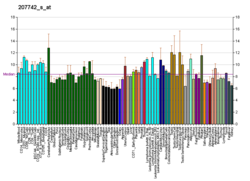The germ cell nuclear factor (GCNF), also known as RTR (retinoid receptor-related testis-associated receptor) or NR6A1 (nuclear receptor subfamily 6, group A, member 1), is a protein that in humans is encoded by the NR6A1 gene.[5][6] GCNF is a member of the nuclear receptor family of intracellular transcription factors .
In adults, GCNH is expressed mainly in the germ cells of gonads and is involved in the regulation of embryogenesis and germ cell differentiation.[7]
Its expression pattern suggests that it may be involved in neurogenesis and germ cell development. The protein can homodimerize and bind DNA, but in vivo targets have not been identified. The gene expresses three alternatively spliced transcript variants.[8]
In cells undergoing homologous recombination during meiosis, DNA intermediates are processed as an essential step in the exchange of information between parental homologous chromosomes. In eukaryotes the RTR complex, which consists of a type IA topoisomerase, a RecQ helicase and the structural protein RMI1, is employed in processing DNA recombination intermediates.[9]
References
[edit]- ^ a b c GRCh38: Ensembl release 89: ENSG00000148200 – Ensembl, May 2017
- ^ a b c GRCm38: Ensembl release 89: ENSMUSG00000063972 – Ensembl, May 2017
- ^ "Human PubMed Reference:". National Center for Biotechnology Information, U.S. National Library of Medicine.
- ^ "Mouse PubMed Reference:". National Center for Biotechnology Information, U.S. National Library of Medicine.
- ^ Lei W, Hirose T, Zhang LX, Adachi H, Spinella MJ, Dmitrovsky E, Jetten AM (Apr 1997). "Cloning of the human orphan receptor germ cell nuclear factor/retinoid receptor-related testis-associated receptor and its differential regulation during embryonal carcinoma cell differentiation". Journal of Molecular Endocrinology. 18 (2): 167–76. doi:10.1677/jme.0.0180167. PMID 9134503.
- ^ Süsens U, Borgmeyer U (Dec 1996). "Characterization of the human germ cell nuclear factor gene". Biochimica et Biophysica Acta (BBA) - Gene Structure and Expression. 1309 (3): 179–82. doi:10.1016/s0167-4781(96)00157-1. PMID 8982251.
- ^ Zechel C (Dec 2005). "The germ cell nuclear factor (GCNF)". Molecular Reproduction and Development. 72 (4): 550–6. doi:10.1002/mrd.20377. PMID 16155958. S2CID 39315293.
- ^ "Entrez Gene: NR6A1 nuclear receptor subfamily 6, group A, member 1".
- ^ Knoll A, Schröpfer S, Puchta H (2014). "The RTR complex as caretaker of genome stability and its unique meiotic function in plants". Front Plant Sci. 5: 33. doi:10.3389/fpls.2014.00033. PMC 3921566. PMID 24575106.
Further reading
[edit]- Greschik H, Schüle R (1999). "Germ cell nuclear factor: an orphan receptor with unexpected properties". Journal of Molecular Medicine. 76 (12): 800–10. doi:10.1007/s001090050284. PMID 9846950. S2CID 9368668.
- Hirose T, O'Brien DA, Jetten AM (Jan 1995). "RTR: a new member of the nuclear receptor superfamily that is highly expressed in murine testis". Gene. 152 (2): 247–51. doi:10.1016/0378-1119(94)00656-D. PMID 7835709.
- Yan ZH, Medvedev A, Hirose T, Gotoh H, Jetten AM (Apr 1997). "Characterization of the response element and DNA binding properties of the nuclear orphan receptor germ cell nuclear factor/retinoid receptor-related testis-associated receptor". The Journal of Biological Chemistry. 272 (16): 10565–72. doi:10.1074/jbc.272.16.10565. PMID 9099702.
- Kapelle M, Krätzschmar J, Husemann M, Schleuning WD (May 1997). "cDNA cloning of two closely related forms of human germ cell nuclear factor (GCNF)". Biochimica et Biophysica Acta (BBA) - Gene Structure and Expression. 1352 (1): 13–7. doi:10.1016/s0167-4781(97)00043-2. PMID 9177477.
- Agoulnik IY, Cho Y, Niederberger C, Kieback DG, Cooney AJ (Mar 1998). "Cloning, expression analysis and chromosomal localization of the human nuclear receptor gene GCNF". FEBS Letters. 424 (1–2): 73–8. Bibcode:1998FEBSL.424...73A. doi:10.1016/S0014-5793(98)00142-2. PMID 9537518. S2CID 26848550.
- Greschik H, Wurtz JM, Hublitz P, Köhler F, Moras D, Schüle R (Jan 1999). "Characterization of the DNA-binding and dimerization properties of the nuclear orphan receptor germ cell nuclear factor". Molecular and Cellular Biology. 19 (1): 690–703. doi:10.1128/mcb.19.1.690. PMC 83926. PMID 9858592.
- Schmitz TP, Süsens U, Borgmeyer U (Sep 1999). "DNA binding, protein interaction and differential expression of the human germ cell nuclear factor". Biochimica et Biophysica Acta (BBA) - Gene Structure and Expression. 1446 (3): 173–80. doi:10.1016/s0167-4781(99)00079-2. PMID 10524192.
- Yan Z, Jetten AM (Nov 2000). "Characterization of the repressor function of the nuclear orphan receptor retinoid receptor-related testis-associated receptor/germ cell nuclear factor". The Journal of Biological Chemistry. 275 (45): 35077–85. doi:10.1074/jbc.M005566200. PMID 10940306.
- Süsens U, Borgmeyer U (2001). "Genomic structure of the gene for mouse germ-cell nuclear factor (GCNF). II. Comparison with the genomic structure of the human GCNF gene". Genome Biology. 2 (5): RESEARCH0017. doi:10.1186/gb-2001-2-5-research0017. PMC 32189. PMID 11387038.
- Mehta DV, Kim YS, Dixon D, Jetten AM (Apr 2002). "Characterization of the expression of the retinoid-related, testis-associated receptor (RTR) in trophoblasts". Placenta. 23 (4): 281–7. doi:10.1053/plac.2001.0779. PMID 11969338.
- Yan Z, Kim YS, Jetten AM (Aug 2002). "RAP80, a novel nuclear protein that interacts with the retinoid-related testis-associated receptor". The Journal of Biological Chemistry. 277 (35): 32379–88. doi:10.1074/jbc.M203475200. PMID 12080054.
- Lan ZJ, Chung AC, Xu X, DeMayo FJ, Cooney AJ (Dec 2002). "The embryonic function of germ cell nuclear factor is dependent on the DNA binding domain". The Journal of Biological Chemistry. 277 (52): 50660–7. doi:10.1074/jbc.M209586200. PMID 12381721.
- Yang G, Zhang YL, Buchold GM, Jetten AM, O'Brien DA (May 2003). "Analysis of germ cell nuclear factor transcripts and protein expression during spermatogenesis". Biology of Reproduction. 68 (5): 1620–30. doi:10.1095/biolreprod.102.012013. PMID 12606326.
- Rajkovic M, Middendorff R, Wetzel MG, Frkovic D, Damerow S, Seitz HJ, Weitzel JM (Dec 2004). "Germ cell nuclear factor relieves cAMP-response element modulator tau-mediated activation of the testis-specific promoter of human mitochondrial glycerol-3-phosphate dehydrogenase". The Journal of Biological Chemistry. 279 (50): 52493–9. doi:10.1074/jbc.M404467200. PMID 15456763.
External links
[edit]- NR6A1+protein,+human at the U.S. National Library of Medicine Medical Subject Headings (MeSH)






